Silica-Containing Biomimetic Composites Based on Sea Urchin Skeleton and Polycalcium Organyl Silsesquioxane
Abstract
1. Introduction
2. Materials and Methods
2.1. Materials
2.2. Synthesis Methods
2.2.1. Synthesis of Polyethyl Silsesquioxane (PES)
2.2.2. Synthesis of Polyphenyl Silsesquioxane (PPhS)
2.2.3. Synthesis of Polycalcium Ethylsilsesquioxane (PCaES)
2.2.4. Synthesis of Polycalcium Phenylsilsesquioxane (PCaPhS)
2.2.5. Synthesis of Composite 1
2.2.6. Synthesis of Composite 2
2.3. Material Characterization Methods
3. Results and Discussion
4. Conclusions
Author Contributions
Funding
Institutional Review Board Statement
Acknowledgments
Conflicts of Interest
References
- Studart, A.R. Towards High-Performance Bioinspired Composites. Adv. Mater. 2012, 24, 5024–5044. [Google Scholar] [CrossRef]
- Cojocaru, F.D.; Balan, V.; Tanase, C.-E.; Popa, I.M.; Butnaru, M.; Bredetean, O.; Mares, M.; Nastasa, V.; Pasca, S.; Verestiuc, L. Development and Characterisation of Microporous Biomimetic Scaffolds Loaded with Magnetic Nanoparticles as Bone Repairing Material. Ceram. Int. 2021, 47, 11209–11219. [Google Scholar] [CrossRef]
- Cruz, E.; Hubert, T.; Chancoco, G.; Naim, O.; Chayaamor-Heil, N.; Cornette, R.; Menezo, C.; Badarnah, L.; Raskin, K.; Aujard, F. Design Processes and Multi-Regulation of Biomimetic Building Skins: A Comparative Analysis. Energy Build. 2021, 246, 111034. [Google Scholar] [CrossRef]
- Wang, R.; Yan, H.; Yu, A.; Ye, L.; Zhai, G. Cancer Targeted Biomimetic Drug Delivery System. J. Drug Deliv. Sci. Technol. 2021, 63, 102530. [Google Scholar] [CrossRef]
- Baldino, L.; Aragón, J.; Mendoza, G.; Irusta, S.; Cardea, S.; Reverchon, E. Production, Characterization and Testing of Antibacterial PVA Membranes Loaded with HA-Ag3PO4 Nanoparticles, Produced by SC-CO2 Phase Inversion. J. Chem. Technol. Biotechnol. 2019, 94, 98–108. [Google Scholar] [CrossRef]
- Ajmal, G.; Bonde, G.V.; Mittal, P.; Khan, G.; Pandey, V.K.; Bakade, B.V.; Mishra, B. Biomimetic PCL-Gelatin Based Nanofibers Loaded with Ciprofloxacin Hydrochloride and Quercetin: A Potential Antibacterial and Anti-Oxidant Dressing Material for Accelerated Healing of a Full Thickness Wound. Int. J. Pharm. 2019, 567, 118480. [Google Scholar] [CrossRef]
- Martín-Palma, R.J.; Kolle, M. [INVITED] Biomimetic Photonic Structures for Optical Sensing. Opt. Laser Technol. 2019, 109, 270–277. [Google Scholar] [CrossRef]
- Romanholo, P.V.V.; Razzino, C.A.; Raymundo-Pereira, P.A.; Prado, T.M.; Machado, S.A.S.; Sgobbi, L.F. Biomimetic Electrochemical Sensors: New Horizons and Challenges in Biosensing Applications. Biosens. Bioelectron. 2021, 185, 113242. [Google Scholar] [CrossRef]
- Zhao, L.; Yang, H.; He, F.; Yao, Y.; Xu, R.; Wang, L.; He, L.; Zhang, H.; Li, S.; Huang, F. Biomimetic N-Doped Sea-Urchin-Structured Porous Carbon for the Anode Material of High-Energy-Density Potassium-Ion Batteries. Electrochim. Acta 2021, 388, 138565. [Google Scholar] [CrossRef]
- Han, X.; Wu, J.; Zhang, X.; Shi, J.; Wei, J.; Yang, Y.; Wu, B.; Feng, Y. Special Issue on Advanced Corrosion-Resistance Materials and Emerging Applications. The Progress on Antifouling Organic Coating: From Biocide to Biomimetic Surface. J. Mater. Sci. Technol. 2021, 61, 46–62. [Google Scholar] [CrossRef]
- Li, W.; Pei, Y.; Zhang, C.; Kottapalli, A.G.P. Bioinspired Designs and Biomimetic Applications of Triboelectric Nanogenerators. Nano Energy 2021, 84, 105865. [Google Scholar] [CrossRef]
- Al-Ketan, O.; Rowshan, R.; Alami, A.H. Biomimetic Materials for Engineering Applications. In Encyclopedia of Smart Materials; Elsevier: Amsterdam, The Netherlands, 2022; pp. 25–34. [Google Scholar]
- Park, C.W.; Lee, J.-H.; Seo, J.K.; Ran, W.T.A.; Whang, D.; Hwang, S.M.; Kim, Y.-J. Graphene/PVDF Composites for Ni-Rich Oxide Cathodes toward High-Energy Density Li-Ion Batteries. Materials 2021, 14, 2271. [Google Scholar] [CrossRef] [PubMed]
- Kamedulski, P.; Lukaszewicz, J.P.; Witczak, L.; Szroeder, P.; Ziolkowski, P. The Importance of Structural Factors for the Electrochemical Performance of Graphene/Carbon Nanotube/Melamine Powders towards the Catalytic Activity of Oxygen Reduction Reaction. Materials 2021, 14, 2448. [Google Scholar] [CrossRef]
- Chae, G.; Youn, D.; Lee, J. Nanostructured Iron Sulfide/N, S Dual-Doped Carbon Nanotube-Graphene Composites as Efficient Electrocatalysts for Oxygen Reduction Reaction. Materials 2021, 14, 2146. [Google Scholar] [CrossRef]
- Christian, J.R.; Grant, C.G.J.; Meade, J.D.; Noble, L.D. Habitat Requirements and Life History Characteristics of Selected Marine Invertebrate Species Occurring in the Newfoundland and Labrador Region. Can. Manuscr. Rep. Fish. Aquat. Sci. 2010, 2925, 1–207. [Google Scholar]
- Chen, Y.-C.; Lin, C.-L.; Li, C.-T.; Hwang, D.-F. Structural Transformation of Oyster, Hard Clam, and Sea Urchin Shells after Calcination and Their Antibacterial Activity against Foodborne Microorganisms. Fish. Sci. 2015, 81, 787–794. [Google Scholar] [CrossRef]
- Yang, T.; Wu, Z.; Chen, H.; Zhu, Y.; Li, L. Quantitative 3D Structural Analysis of the Cellular Microstructure of Sea Urchin Spines (I): Methodology. Acta Biomater. 2020, 107, 204–217. [Google Scholar] [CrossRef]
- Shapkin, N.P.; Khalchenko, I.G.; Panasenko, A.E.; Drozdov, A.L. Sea Urchin Skeleton: Structure, Composition, and Application as a Template for Biomimetic Materials. AIP Conf. Proc. 2017, 1858, 020006. [Google Scholar]
- Antoniac, I.V.; Lesci, I.G.; Blajan, A.I.; Vitioanu, G.; Antoniac, A. Bioceramics and Biocomposites from Marine Sources. Key Eng. Mater. 2016, 672, 276–292. [Google Scholar] [CrossRef]
- Lim, Y.-S.; Ok, Y.-J.; Hwang, S.-Y.; Kwak, J.-Y.; Yoon, S. Marine Collagen as A Promising Biomaterial for Biomedical Applications. Mar. Drugs 2019, 17, 467. [Google Scholar] [CrossRef]
- Yücel, A.; Sezer, S.; Birhanlı, E.; Ekinci, T.; Yalman, E.; Depci, T. Synthesis and Characterization of Whitlockite from Sea Urchin Skeleton and Investigation of Antibacterial Activity. Ceram. Int. 2021, 47, 626–633. [Google Scholar] [CrossRef]
- Maddocks, A.R.; Harris, A.T. Biotemplated Synthesis of Novel Porous SiC. Mater. Lett. 2009, 63, 748–750. [Google Scholar] [CrossRef]
- Grun, T.B.; Nebelsick, J.H. Technical Biology of the Clypeasteroid Echinoid Echinocyamus Pusillus: A Review. Contemp. Trends Geosci. J. Uniw. Slaski 2018, 7, 247–254. [Google Scholar]
- Grun, T.B.; von Scheven, M.; Geiger, F.; Schwinn, T.; Sonntag, D.; Bischoff, M.; Knippers, J.; Menges, A.; Nebelsick, J.H. Bauprinzipien Und Strukturdesign von Seeigeln—Vorbilder Für Bioinspirierte Konstruktionen. In Bionisch Bauen; De Gruyter: Berlin, Germany, 2019; pp. 104–115. ISBN 9783035617870. [Google Scholar]
- Grun, T.B.; Nebelsick, J.H. Structural Design of the Echinoid’s Trabecular System. PLoS ONE 2018, 13, e0204432. [Google Scholar] [CrossRef]
- Lauer, C.; Grun, T.B.; Zutterkirch, I.; Jemmali, R.; Nebelsick, J.H.; Nickel, K.G. Morphology and Porosity of the Spines of the Sea Urchin Heterocentrotus Mamillatus and Their Implications on the Mechanical Performance. Zoomorphology 2018, 137, 139–154. [Google Scholar] [CrossRef]
- Drozdov, A.L.; Sharmankina, V.V. Ultrastructure of Spines in Heart Urchins of the Genus Echinocardium. IJSR 2020, 9, 896–901. [Google Scholar]
- Shapkin, N.P.; Papynov, E.K.; Panasenko, A.E.; Khalchenko, I.G.; Mayorov, V.Y.; Drozdov, A.L.; Maslova, N.V.; Buravlev, I.Y. Synthesis of Porous Biomimetic Composites: A Sea Urchin Skeleton Used as a Template. Appl. Sci. 2021, 11, 8897. [Google Scholar] [CrossRef]
- Klang, K.; Nickel, K.G. The Plant-Like Structure of Lance Sea Urchin Spines as Biomimetic Concept Generator for Freeze-Casted Structural Graded Ceramics. Biomimetics 2021, 6, 36. [Google Scholar] [CrossRef]
- Hamil, S.; Baha, M.; Abdi, A.; Alili, M.; Bilican, B.K.; Yilmaz, B.A.; Cakmak, Y.S.; Bilican, I.; Kaya, M. Use of Sea Urchin Spines with Chitosan Gel for Biodegradable Film Production. Int. J. Biol. Macromol. 2020, 152, 102–108. [Google Scholar] [CrossRef]
- Meldrum, F. “Bio-Casting”: Biomineralized Skeletons as Templates for Macroporous Structures. In Handbook of Biomineralization; Wiley-VCH Verlag GmbH: Weinheim, Germany, 2007; pp. 289–309. [Google Scholar]
- Triunfo, C.; Gärtner, S.; Marchini, C.; Fermani, S.; Maoloni, G.; Goffredo, S.; Gomez Morales, J.; Cölfen, H.; Falini, G. Recovering and Exploiting Aragonite and Calcite Single Crystals with Biologically Controlled Shapes from Mussel Shells. ACS Omega 2022, 7, 43992–43999. [Google Scholar] [CrossRef]
- Lee, H.J.; Yang, J.H.; You, J.H.; Yoon, B.Y. Sea-Urchin-like Mesoporous Copper-Manganese Oxide Catalysts: Influence of Copper on Benzene Oxidation. J. Ind. Eng. Chem. 2020, 89, 156–165. [Google Scholar] [CrossRef]
- Papynov, E.K.; Shichalin, O.O.; Kapustina, O.V.; Buravlev, I.Y.; Apanasevich, V.I.; Mayorov, V.Y.; Fedorets, A.N.; Lembikov, A.O.; Gritsuk, D.N.; Ovodova, A.V.; et al. Synthetic Calcium Silicate Biocomposite Based on Sea Urchin Skeleton for 5-Fluorouracil Cancer Delivery. Materials 2023, 16, 3495. [Google Scholar] [CrossRef]
- Weber, J.N. The Incorporation of Magnesium into the Skeletal Calcites of Echinoderms. Am. J. Sci. 1969, 267, 537–566. [Google Scholar] [CrossRef]
- Moureaux, C.; Pérez-Huerta, A.; Compère, P.; Zhu, W.; Leloup, T.; Cusack, M.; Dubois, P. Structure, Composition and Mechanical Relations to Function in Sea Urchin Spine. J. Struct. Biol. 2010, 170, 41–49. [Google Scholar] [CrossRef] [PubMed]
- Gridyushko, A.; Chentemirova, E.G. Biomimetic Shaping Principles of Vertical Farms as a New Typology of Agro-Indastrial Architecture. AMIT 2013, 4, 1–11. [Google Scholar]
- Tokar, E.A.; Vavrenyk, S.V.; Krasitskaya, S.G. Investigation of Cement Compositions Modification with Organosilicon Compounds. IOP Conf. Ser. Mater. Sci. Eng. 2017, 262, 012015. [Google Scholar] [CrossRef]
- Shapkin, N.P.; Alikovsky, A.V.; Shapkina, V.Y. Investigation of Interaction of Sodium Salts of Dibutylphosphinic Acid and Phenylsiliconate with Chlorides of Some Metals. Russ. J. Gen. Chem. 1987, 57, 321–329. (In Russian) [Google Scholar]
- Shapkin, N.P.; Kulchin, Y.N.; Razov, V.I.; Voznesenskii, S.S.; Bazhenov, V.V.; Tutov, M.V.; Stavnisty, N.N.; Kuryavy, V.G.; Sloboduk, A.B. Study of Polyvinyl- and Polyphenylsilsesquioxanes by X-ray Diffractometry, Positron Diagnostics, 29Si NMR Spectroscopy and Study of Films Based on Them. Izv. Acad. Sci. Russ. Fed. 2011, 60, 1614–1620. (In Russian) [Google Scholar] [CrossRef]
- Kapustina, A.A.; Shapkin, N.P.; Ivanova, E.B.; Lyakhina, A.A. Mechanochemical Synthesis of Poly (Germanium and Tin Organosiloxanes). Russ. J. Gen. Chem. 2005, 75, 571–574. [Google Scholar] [CrossRef]
- Kapustina, A.A.; Shapkin, N.P.; Libanov, V.V. Preparation of Polyboronphenylsiloxanes by Mechanochemical Activation. Russ. J. Gen. Chem. 2014, 84, 1320–1324. [Google Scholar] [CrossRef]
- Kapustina, A.A.; Libanov, V.V.; Shapkin, N.P.; Pobozhev, K.V. The Study of the Interaction of Aluminum Acetylacetonate with Polyphenylsilsesquioxane with the Help of Mechanochemical Activation. ChemChemTech 2022, 65, 59–66. [Google Scholar] [CrossRef]
- Kapustina, A.A.; Shapkin, N.P.; Makedonskaya, E.S. Synthesis of Ferrodiphenylsiloxanes by Mechanochemical Activation. Butlerov Commun. 2010, 19, 7–11. (In Russian) [Google Scholar]
- Kapustina, A.A.; Shapkin, N.P.; Merkulova, E.A.; Libanov, V.V. Study of the Possibility of Synthesis of Polyphenylsiloxanes by Interaction of Polyphenylsiloxane with Copper Acetylacetonate under Mechanochemical Activation Conditions. Butlerov Commun. 2017, 51, 84–87. (In Russian) [Google Scholar]
- Ding, J.; Yang, D.; Wang, H.; Zuo, R.; Qi, S.; Han, L.; Chang, Y. Cloning, Characterization and Transcription Analysis of Fatty Acyl Desaturase (Δ6Fad-like) and Elongase (Elovl4-like, Elove5-like) during Embryos Development of Strongylocentrotus Intermedius. Aquac. Res. 2019, 50, 3483–3492. [Google Scholar] [CrossRef]
- Mijangos, L.; Krauss, M.; de Miguel, L.; Ziarrusta, H.; Olivares, M.; Zuloaga, O.; Izagirre, U.; Schulze, T.; Brack, W.; Prieto, A.; et al. Application of the Sea Urchin Embryo Test in Toxicity Evaluation and Effect-Directed Analysis of Wastewater Treatment Plant Effluents. Environ. Sci. Technol. 2020, 54, 8890–8899. [Google Scholar] [CrossRef]
- Sahara, H.; Ishikawa, M.; Takahashi, N.; Ohtani, S.; Sato, N.; Gasa, S.; Akino, T.; Kikuchi, K. In Vivo Anti-Tumour Effect of 3′-Sulphonoquinovosyl 1′-Monoacylglyceride Isolated from Sea Urchin (Strongylocentrotus Intermedius) Intestine. Br. J. Cancer 1997, 75, 324–332. [Google Scholar] [CrossRef]
- Shapkin, N.P.; Kapustina, A.A.; Dombai, N.V.; Libanov, V.V.; Khalchenko, I.G.; Gardionov, S.V.; Gribova, V.V. Synthesis and Physicochemical Characteristics of Polymolybdenum(VI) Phenylsiloxanes by Means of Different Methods. Polym. Bull. 2020, 77, 1177–1190. [Google Scholar] [CrossRef]
- Averko-Antonovich, I.Y. Methods of Study of Polymer Structure and Properties; Kazan National Research Technological University: Kazan, Russia, 2002. (In Russian) [Google Scholar]
- Andrianov, K.A.; Kononov, A.N.; Tsvankin, D.Y. X-ray Diffraction Study of Some Organosilicon Polymers. High Mol. Weight Compd. Short Commun. 1968, B, 320–323. (In Russian) [Google Scholar]
- Jaber, M.; Miehé-Brendlé, J.; Roux, M.; Dentzer, J.; Le Dred, R.; Guth, J.-L. A New Al, Mg-Organoclay. New J. Chem. 2002, 26, 1597–1600. [Google Scholar] [CrossRef]
- Miller, R.L.; Boyer, R.F. Regularities in X-ray Scattering Patterns from Amorphous Polymers. J. Polym. Sci. Polym. Phys. Ed. 1984, 22, 2043–2050. [Google Scholar] [CrossRef]
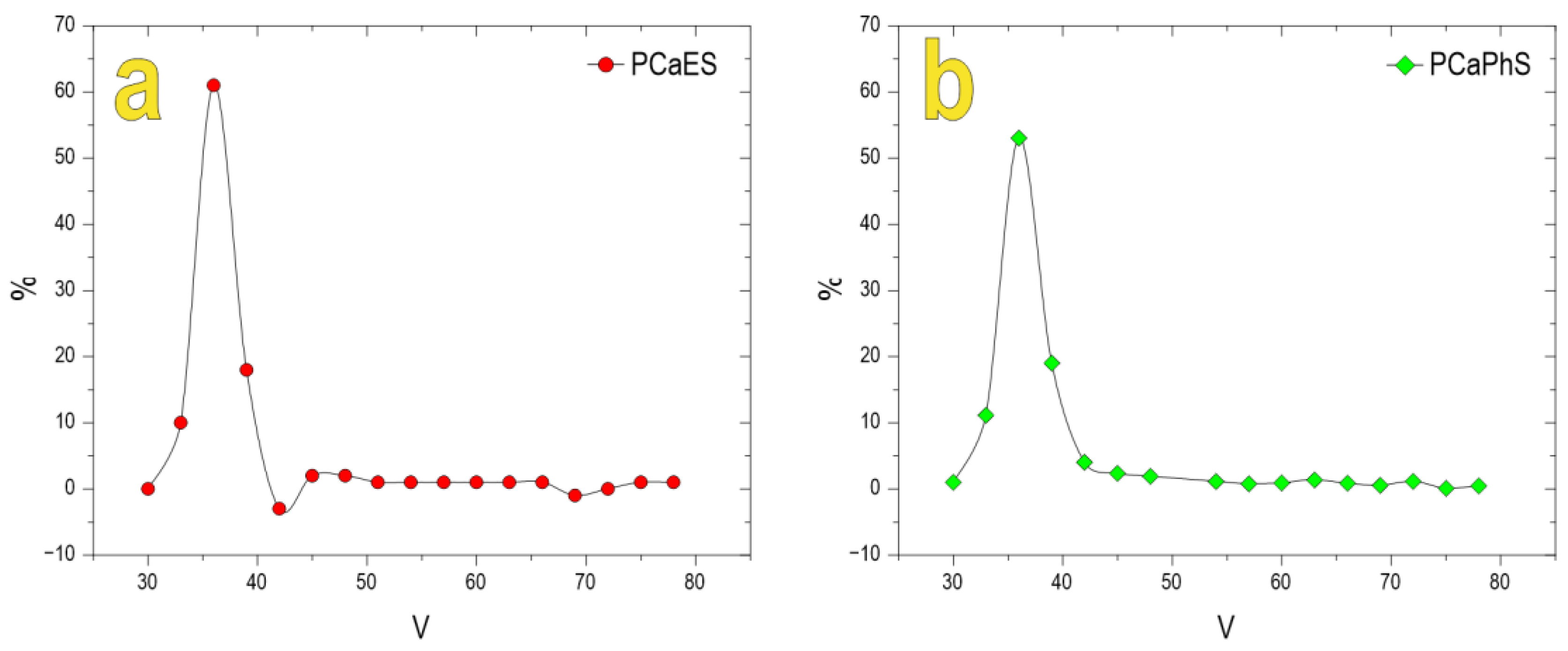
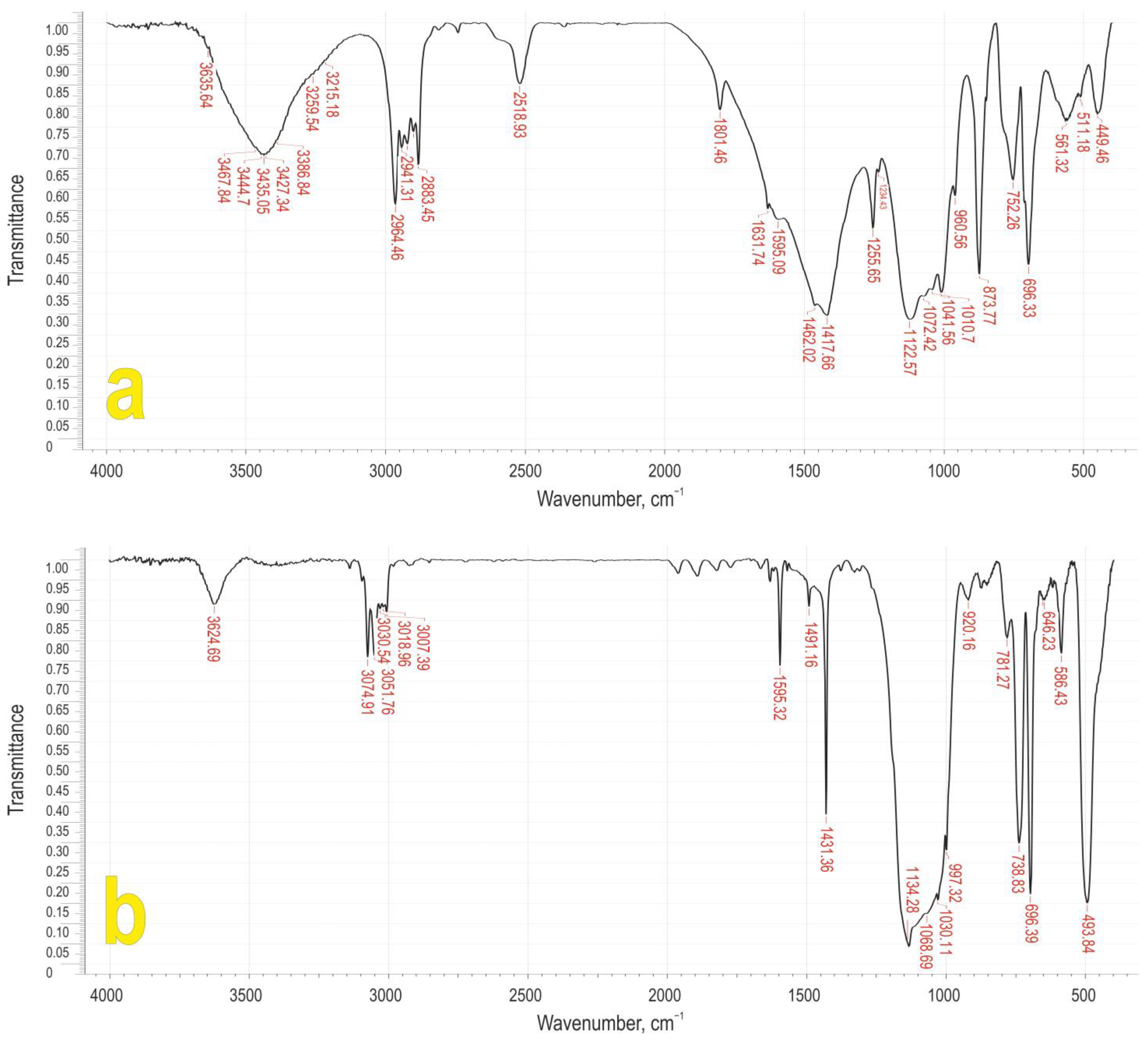
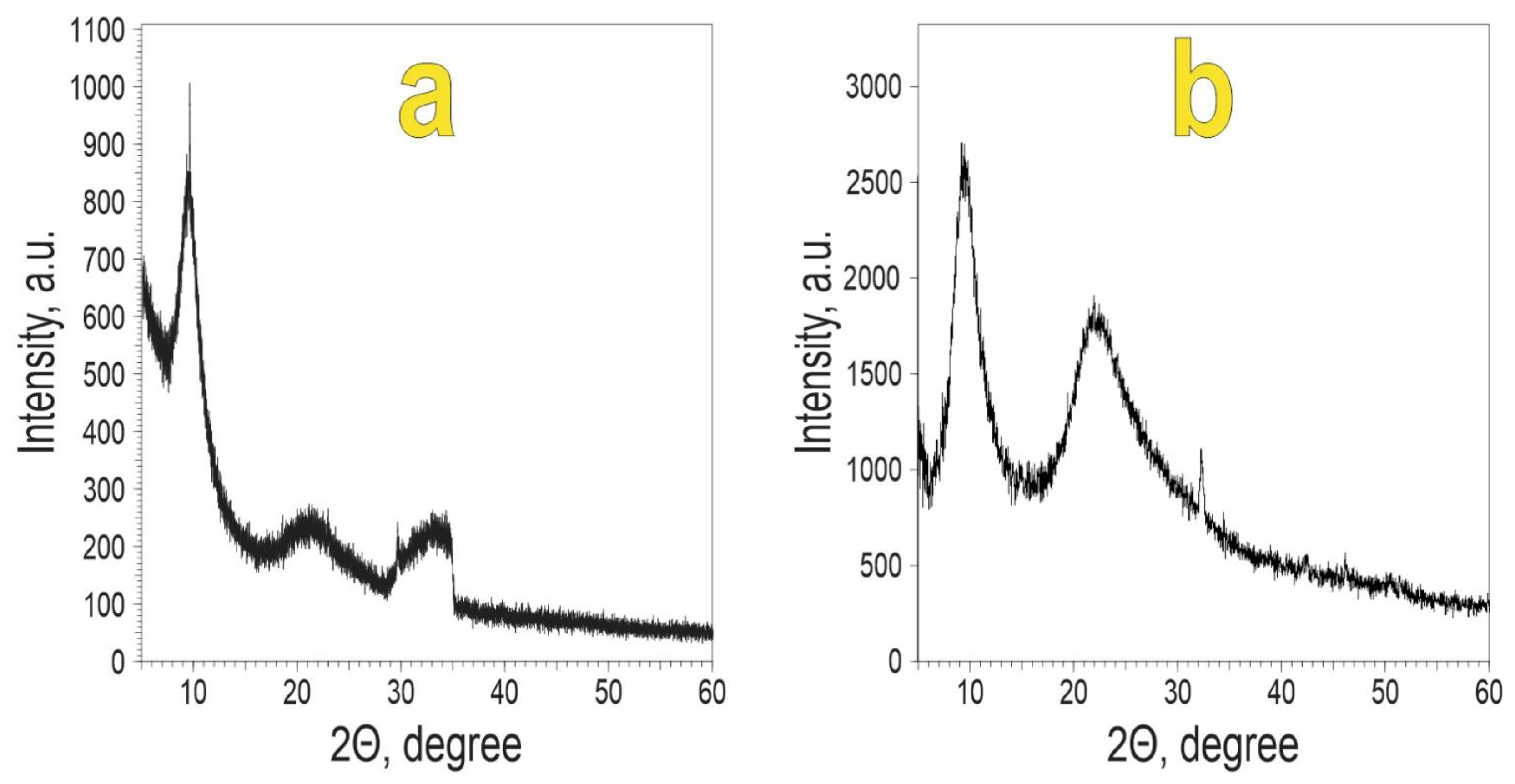
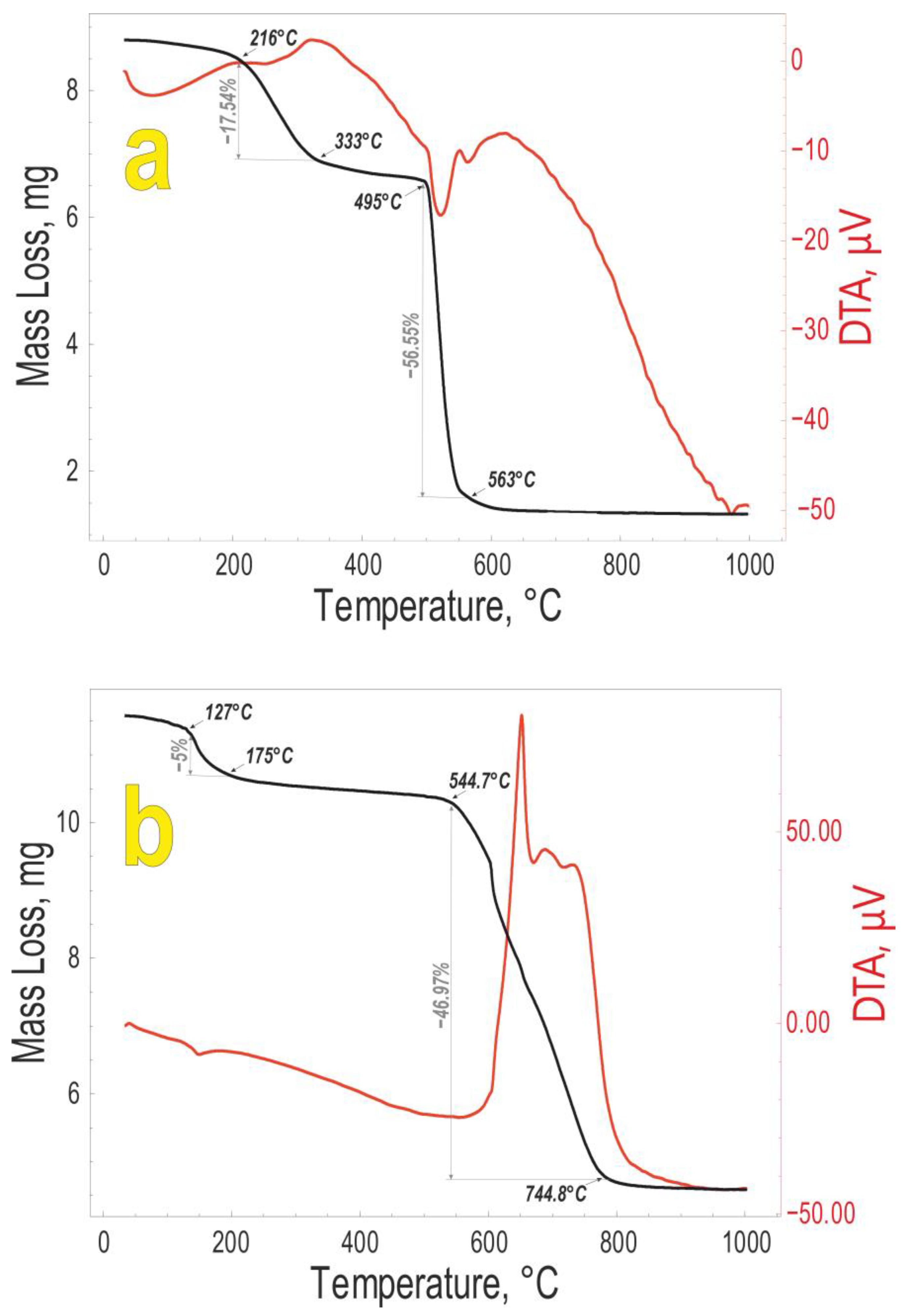
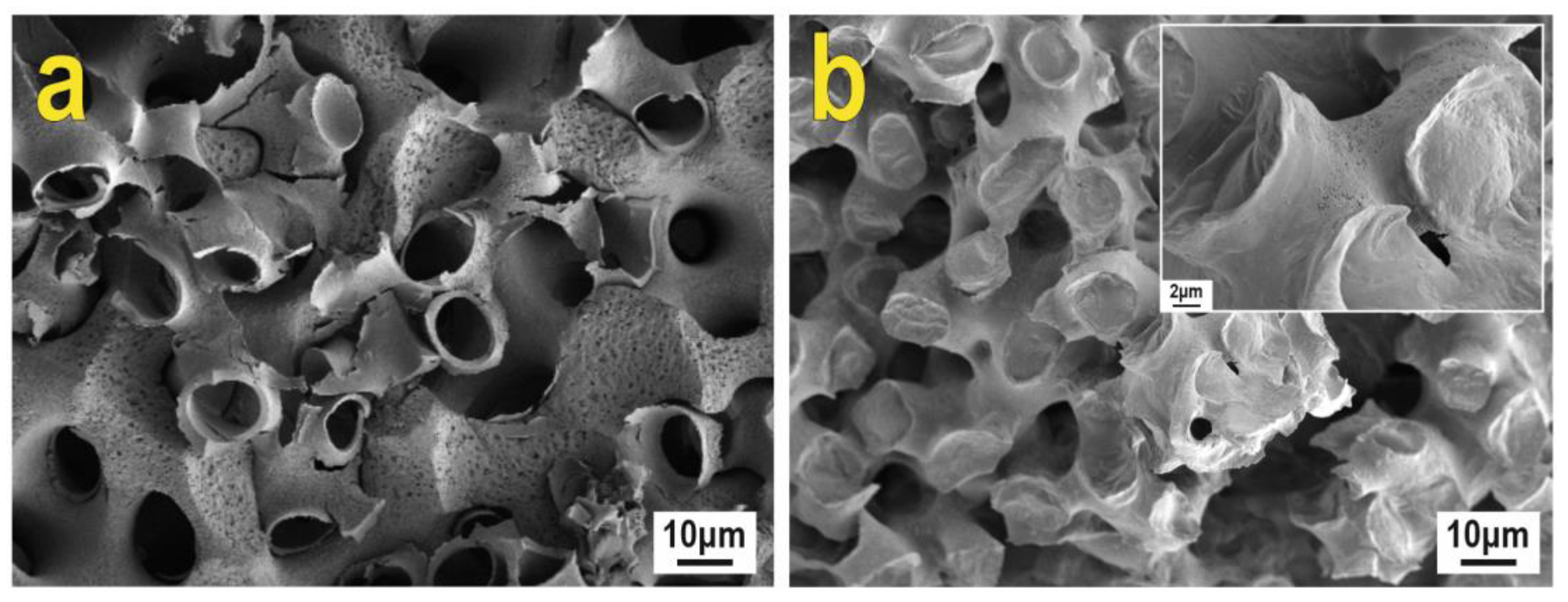
| Polymer | Found, % | Calculated, % | Mass Yield, % | Gross Formula | ||
|---|---|---|---|---|---|---|
| C | Si | C | Si | |||
| PES | 30.9 | 32.2 | 30.6 | 33.6 | 95.4 | [(C2H5SiO1.5)0.97∙0.03C4H9OH]n |
| PPhS | 54.1 | 21.5 | 54.5 | 21.2 | 93.7 | [C6H5SiO1.5∙0.17H2O]n |
| Polymer | Found, % | Calculated, % | Mass Yield, % | Gross Formula | ||||
|---|---|---|---|---|---|---|---|---|
| C | Si | Ca | C | Si | Ca | |||
| PCaES | 19.9 | 17.6 | 17.3 | 19.8 | 18.4 | 17.5 | 93.2 | [(C2H5SiO1.5)1.45(CaO)0.45 (CaHCO3)0.05]∙3H2O |
| PCaPhS | 37.5 | 21.8 | 16.2 | 34.2 | 21.0 | 15.8 | 65.4 | [(PhSiO1.5)1.2(SiO2)0.7CaO] |
| Polymer | d100, nm | L, Å | S, nm2 | V, Å3 |
|---|---|---|---|---|
| PES | 0.98 | 13.70 | 0.78 | 1061.75 |
| PCaES | 0.92 | 35.03 | 0.70 | 2447.35 |
| PPhS | 1.20 | 12.50 | 1.09 | 1350.00 |
| PCaPhS | 1.27 | 30.26 | 1.18 | 3562.71 |
| Ratio | PCaES | PCaPhS | Composite 1 | Composite 2 |
|---|---|---|---|---|
| Si/Ca | 1.5 | 1.9 | 1.33 | 2.4 |
Disclaimer/Publisher’s Note: The statements, opinions and data contained in all publications are solely those of the individual author(s) and contributor(s) and not of MDPI and/or the editor(s). MDPI and/or the editor(s) disclaim responsibility for any injury to people or property resulting from any ideas, methods, instructions or products referred to in the content. |
© 2023 by the authors. Licensee MDPI, Basel, Switzerland. This article is an open access article distributed under the terms and conditions of the Creative Commons Attribution (CC BY) license (https://creativecommons.org/licenses/by/4.0/).
Share and Cite
Shapkin, N.P.; Khalchenko, I.G.; Drozdov, A.L.; Fedorets, A.N.; Buravlev, I.Y.; Andrasyuk, A.A.; Maslova, N.V.; Pervakov, K.A.; Papynov, E.K. Silica-Containing Biomimetic Composites Based on Sea Urchin Skeleton and Polycalcium Organyl Silsesquioxane. Biomimetics 2023, 8, 300. https://doi.org/10.3390/biomimetics8030300
Shapkin NP, Khalchenko IG, Drozdov AL, Fedorets AN, Buravlev IY, Andrasyuk AA, Maslova NV, Pervakov KA, Papynov EK. Silica-Containing Biomimetic Composites Based on Sea Urchin Skeleton and Polycalcium Organyl Silsesquioxane. Biomimetics. 2023; 8(3):300. https://doi.org/10.3390/biomimetics8030300
Chicago/Turabian StyleShapkin, Nikolay P., Irina G. Khalchenko, Anatoliy L. Drozdov, Aleksander N. Fedorets, Igor Yu Buravlev, Anna A. Andrasyuk, Natalya V. Maslova, Kirill A. Pervakov, and Evgeniy K. Papynov. 2023. "Silica-Containing Biomimetic Composites Based on Sea Urchin Skeleton and Polycalcium Organyl Silsesquioxane" Biomimetics 8, no. 3: 300. https://doi.org/10.3390/biomimetics8030300
APA StyleShapkin, N. P., Khalchenko, I. G., Drozdov, A. L., Fedorets, A. N., Buravlev, I. Y., Andrasyuk, A. A., Maslova, N. V., Pervakov, K. A., & Papynov, E. K. (2023). Silica-Containing Biomimetic Composites Based on Sea Urchin Skeleton and Polycalcium Organyl Silsesquioxane. Biomimetics, 8(3), 300. https://doi.org/10.3390/biomimetics8030300








